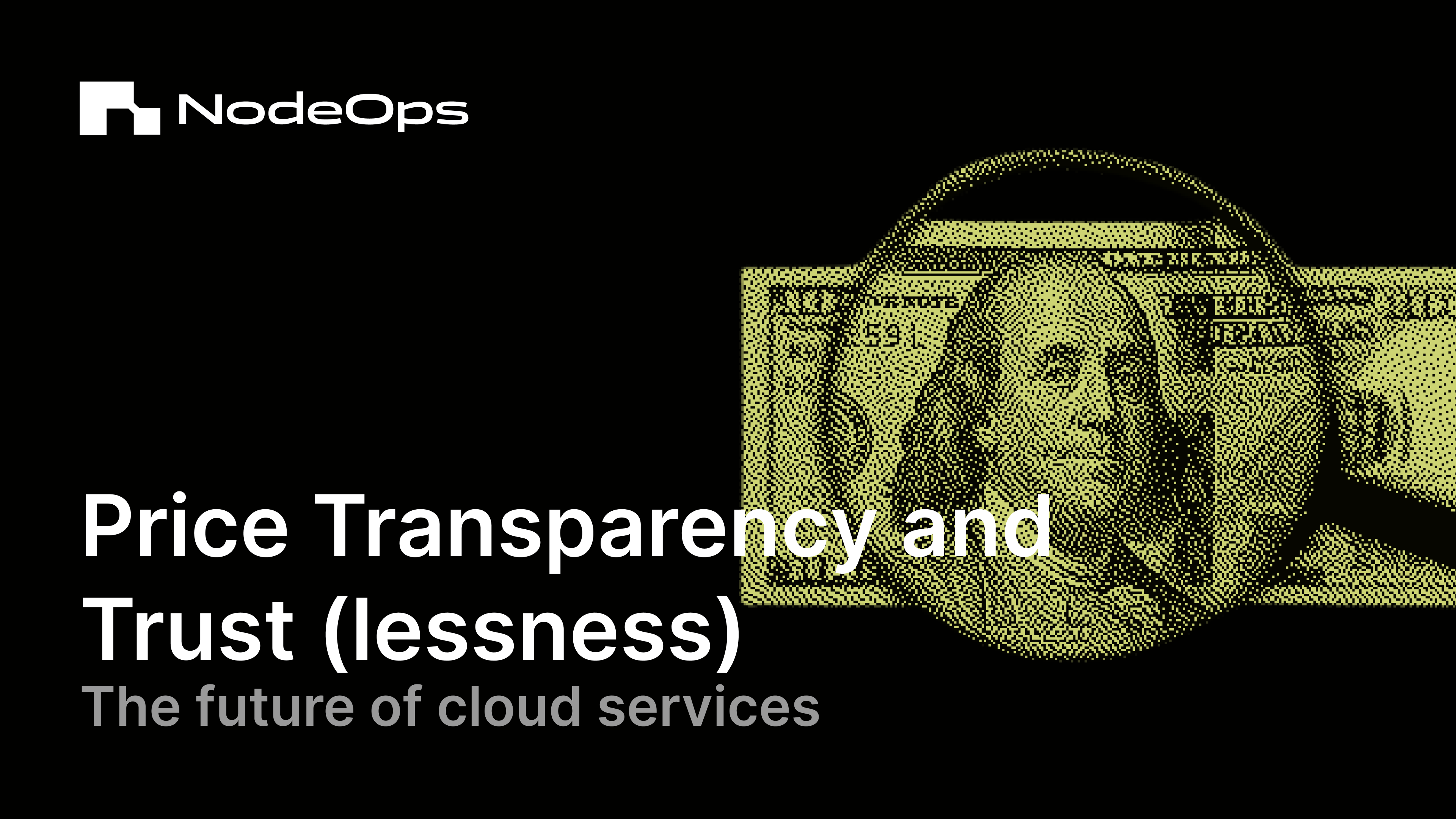Cloud Compute providers such as AWS and Azure are often criticized for their opaque pricing structures and service limitations. This is quantified in a report by Forrester Consulting that reveals, “less than 40% of firms met or exceed goals related to both migration and run costs” and “58% of respondents claim the costs to run their infrastructure in the cloud were higher than estimated".
NodeOps Network believes that our Compute Marketplace provides transparency by offering clear, upfront, competitive pricing with no hidden fees. More than that, we offer Compute providers a revolutionary new Marketplace: one that lets them slash their marketing budget and retire a bench of lawyers.
Cloud Compute models: riddled with frictions
In the competitive cloud computing landscape, AWS, Azure, and Google Cloud dominate, controlling more than 60% of the market. However, the realities of consuming their Cloud Compute present a set of challenges that many businesses find frustrating. Let’s double-click on the concerns and issues of the centralized Cloud.
Censorship
Centralized providers can shut down services without warning, leaving businesses in limbo.
Example: In 2010, WikiLeaks, known for publishing classified information, had its website removed from Amazon Web Services (AWS) hosting.
Exit penalties
One of the biggest pain points with major cloud providers is the complexity and cost of leaving. Providers like AWS and Azure often incentivize customers to sign long-term contracts or commit to Reserved Instances (RIs), which offer discounted rates for long-term use but come with the caveat of significant penalties if the terms are broken. If a customer wants to exit early, they may pay a hefty penalty fee or lose the benefits of the discount entirely. These exit fees are not always easy to predict and can add significant costs to the migration process.
Data transfer costs
Another major obstacle for businesses trying to migrate away from large Cloud Compute providers is the high cost of data egress—the charges associated with transferring data out of the cloud provider’s infrastructure. AWS, for example, charges as much as $0.09 per GB for data transfer out of the platform.
Example: Dropbox transitioned from a fully cloud-based setup to a hybrid cloud environment. Initially, Dropbox used Amazon S3 for its storage needs, but over time, the company decided to create an on-premises platform to better manage costs and gain more control over its data. The migration involved significant challenges, particularly in managing the costs associated with data transfer between their on-premises storage and cloud services.
Lack of price transparency
One of the primary reasons many businesses are frustrated with AWS, Azure, and Google Cloud is the lack of transparency in their pricing models. These providers have complex pricing structures that are often difficult to understand and can change without much notice. Costs for services such as storage, Compute, or even data transfer can quickly spiral out of control.
Example: Spotify migrated from AWS to Google Cloud in 2016. It was reported that AWS’s complex pricing was one of the driving factors behind the decision. As Spotify scaled, understanding AWS’s pricing models became increasingly difficult, leading to unpredictability in their monthly costs.
Hidden Fees
AWS’s “hidden fees” problem isn’t just about pricing complexity; it’s also about unexpected costs that can arise from things like service usage, additional features, and even data retrieval. For example, AWS can charge for additional API calls. Such hidden costs can quickly add up and create unexpected billing.
Example: Netflix has publicly shared that as it scaled its operations, it found that the lack of clear price structures for services like S3 storage and data transfer made it challenging to accurately predict costs. Netflix ultimately spent billions on AWS services, which prompted the company to explore more tailored cloud solutions.
So, why the monopoly?
Many companies report feeling locked in with the larger providers due to opaque terms and the high cost of migration. This presents opportunities for smaller Cloud providers who are willing and able to offer clarity, flexibility, and better exit strategies.
However, it's no easy task for smaller Cloud providers to take market share from the monopolies. To compete with the big 3, businesses need ferocious marketing teams and even when they do come to the attention of potential Compute consumers, they have to overcome the issue that business travels at the speed of trust.
While SLAs are the lifeblood of business cooperation, no one wants to spend their budgets on the lawyers required when services fail to meet their agreed levels. Furthermore, from a Cloud Compute consumer perspective, it's a bit late to be enforcing the consequences of a failed service agreement, as this means their business already took the downtime hit.
NodeOps Network: embedding transparency and trust into cloud Compute
NodeOps Network's DePIN Compute Marketplace offers a revolutionary new approach that solves for the challenges faced by Compute providers keen to win back market share and the Compute consumers who demand more transparent, decentralized Compute.
Protocol-level SLA enforcement
NodeOps Network enables demand-side Compute provision and consumption. As long as a Compute provider maintains their machines according to the SLA, their stake is safe. The stake is the economic incentive that enforces the integrity of the service they provide. This mechanism negates the need for post hoc discussions of the consequences of failing to abide by the SLA: fail, and the stake is slashed. Repeated violations result in the removal of the offending machine—or even the provider—from the network.
This mechanism overcomes the need for Compute consumers to trust providers. Their reputation is earned through their verifiable, on-chain record of their behavior, nothing more or less.
Sorry to the lawyers. It's not just AI coming after your jobs, people, it's smart contracts too!
No more lock-in
As a demand-side model, there are no reserved instances, no more attempting to predict your business' Compute demands in two years time to negotiate fair terms. Instead Compute providers, attracted by the zero marketing and legal demands, will provision Compute in order to earn. This allows Compute consumers to add and reduce Compute as needed.
There are no exit terms, and no more long-term commitments. A demand-side model means no-cost egress, allowing customers to move their data as needed.
If a business decides to migrate their data, well that's, shall we say, their business! If they want to store data with a dedicated data storage DePIN while consuming Compute from NodeOps Network's marketplace, that's entirely their call — and invisible to the marketplace and the ecosystem's other participants.
Flexibility is built into the model.
Transparent pricing with no hidden fees
Consuming Compute from NodeOps Network's Marketplace means upfront pricing with no hidden fees. By offering predictable billing models, the marketplace ensures that customers know exactly what they’re paying for and why. A “no surprises” policy is the best way to build trust with customers and establish a reputation for being transparent and reliable.
A simplified provider model
Blockchain-based DePIN has more to offer than just the protocol-level enforcement of economic alignment. The power of DePIN marketplaces is that they allow tokenization to provide a permissionless and trustless way to bootstrap global networks: creating a flywheel effect that drives network growth and value.
An increase in Compute consumers drives demand for the token, which in turn encourages more providers to join, further expanding the network. This drives up the value of both the network and the token.
By joining such a marketplace, Compute providers can focus on their core product: stable, reliable infrastructure, and directly source new business from the marketplace. No need to build a website or manage attribution funnels—just focus on the core business.
2025: The year of decentralized Compute
Over the last four quarters, the cloud Compute market has grown by almost $16 billion; that’s a 60% growth from the previous four quarters.
In today’s cloud market, transparency and trust (lessness) are key differentiators for those of us competing with centralized providers for the growing market. By focusing on clear exit terms, lower-cost data migration, transparent pricing, and no hidden fees, NodeOps Network’s Compute Marketplace enables the smaller cloud providers to both attract customers and retain them for the long term.
Customers are increasingly aware of the risks of vendor lock-in, the price forecasting challenges, and the financial burdens of migrating away from the big players. We believe that the time is ripe to offer a Cloud solution that’s flexible and customer-centric because customers deserve more control over their Cloud environments.
This article touches on just a few of the cloud Compute vendor lock-in frictions that NodeOps Network solves. We have so much more to reveal about how we address the challenges causing businesses to lose 21-50% of their cloud budget every year. Much of this loss is due to preventable mistakes, so watch this space as we will deep-dive into how NodeOps Node Compute service offers realistic solutions that save your cloud Compute budget for its intended use: driving your business operations.
And, if you haven't already, come join us on NodeOps Network Testnet to help battle-test our Proof of Concept demonstration.






